Net zero carbon no longer refers only to a building’s operational use, as the construction stage can account for half or more of all carbon emissions. Alinea, Orms and Targeting Zero explain how to measure whole life carbon and how the goal of net zero can be reached on office developments
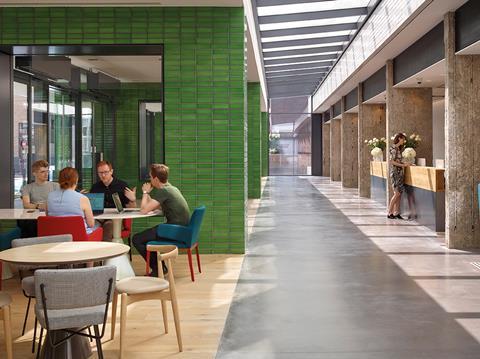
01 / Introduction
“Planet earth is shutting down” was the opening line to a leader in the Economist on 21 March, as governments around the world started to grapple with the apparent dilemma of saving lives or saving economies. Wrapped up within this conundrum is the environmental future of our planet, a reminder that true sustainability requires the optimal balance of wellbeing, money and climate, which are not always easily reconcilable.
Earth may be temporarily “shutting down” but a positive side effect is clear and clean skies, as travel, industry and therefore oil demand have plummeted. One of the beneficiaries has been solar power generation, which has been setting records: in the UK, it peaked in April at 9.68GW, representing almost 30% of our electricity demand – with individuals’ health no doubt improved as levels of toxic pollutants have subsided.
Surely, this will all add weight to the environmental pledges of governments, cities and corporations, acting as catalysts for the creation of sustainable, low‑carbon buildings.
Crises can accelerate trends that were already in play, and together with a concerted effort to reduce real estate’s carbon footprint, these may include: the faster adoption of new technologies; the digitalisation of design and delivery; the recasting of supply chains; and even a real shake-up of the procurement model – all of which can contribute to efforts for net zero carbon.
02 / What is net zero carbon?
Traditionally, net zero carbon has been largely understood to apply only to a building’s operational energy use. Yet for a new commercial building, completed to current standards, emissions from operational energy account for typically just 40%-50% of total lifetime emissions (allowing for grid decarbonisation). A fuller definition of net zero must include embodied emissions from materials sourcing and construction, as well as maintenance, repair, replacement and eventual demolition.
Together, operational and embodied emissions over a building’s entire lifecycle are known as whole life carbon emissions, and any definition of net zero should reflect this complete picture.
The UK Green Building Council, in its Advancing Net Zero, and the London Energy Transformation Initiative (LETI), in its Climate Emergency Design Guide, are moving towards a whole life definition of net zero. This aligns with the RICS professional statement Whole Life Carbon Assessment for the Built Environment, which does not define net zero but provides the methodology for assessing all the carbon emissions of an entire lifecycle – including projections of all landlord and tenant building-related operational emissions.
>> UKGBC: Policy priorities for a green recovery
A further question is what to include from the elements of construction. This scope is still evolving, but the starting point for a commercial development would be to include everything in the cost plan for the base build. Beyond that, assessments will be required for subsequent fit-out works, and for tenants’ operational emissions, such that a complete assessment of embodied carbon – as illustrated in figure 1 below – is established. The final input for a whole life carbon estimate is the analysis of the carbon emitted in the reuse or renewal of the building at the end of its life.
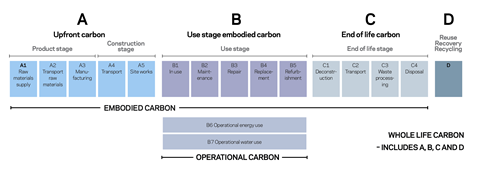
Figure 1: Definitions for whole life carbon assessment
03 / How is whole life carbon measured?
The route to true net zero carbon requires buildings to have a circular lifecycle, where all of the materials and products have been reused and the future impact of dismantling the building enables those same materials and products to be recycled. Additionally, the energy used in producing those materials and installing and dismantling them must have originated from renewable sources.
The amount of carbon used means the aggregate of greenhouse gases released into the atmosphere. The various greenhouse gases that contribute to climate change are converted into their carbon dioxide equivalent (CO2e) to provide a common ground for measurement and tracking.
The RICS and the Greater London Authority (GLA) have published guidance on how to carry out a whole life carbon (WLC) assessment, setting a framework for measuring carbon at four stages of a project lifecycle. Carbon studies have typically focused on tackling one stage at a time, either focusing on upfront carbon – a building’s materials and construction stages (stages A1-A5 in figure 1) – or operational carbon during the life of the building (stages B6-B7). While this methodology is adequate for assessing the key contributors of carbon, to achieve true net zero carbon the entire building lifecycle’s carbon must be calculated. This approach encourages design teams to consider how a building will be occupied and operated.
The process of measuring carbon at each lifecycle stage involves breaking a building down into its constituent parts and applying carbon emission factors to the quantities of each element. In practice, this relies on manufacturers providing carbon emission factors – or, in their absence, then on the use of values based on suitable benchmarking and assumptions. The former are available as environmental product declarations (EPDs), of which there are now about 8,000. Measuring carbon is therefore a detailed process that relies on a number of factors that may change as companies adopt more sustainable approaches.
Like building up a cost plan from rates and prices for individual items to elemental costs, the carbon budget can be built up from detailed analyses, which can be used for benchmark rates to test design options and understand their relative importance in the overall carbon picture.
For example, for a building’s superstructure, a conventional (steel and concrete) frame would account for emissions of 400-500kgCO2e/m², with a hybrid (steel and timber) frame reducing this to 200-350kgCO2e/m², but for a fully timber structure emissions would be only 75-150kgCO2e/m².
This approach can be applied to all building elements across the lifecycle stages, and used as tool for assessing carbon impacts of design options alongside their cost, and other effects.

The carbon model can be built up manually using the templates set out by RICS, but many organisations find it easier to use third-party platforms, such as One Click LCA and eToolLCD. Available tools tend to be based on different methodologies and coverage, meaning that answers calculated by different organisations may be incompatible – something that the GLA model attempts to address.
A WLC assessment is heavily reliant on quantifying the materials and components of an entire building; this will produce more robust results in the later stages of design, when quantities can be measured more accurately. However, to aim for net zero carbon, key decisions need to be made at the beginning of a project, when fundamental design options should be assessed for their environmental impact. This highlights the importance of collaborative benchmark data – something that Alinea is currently developing, working back from more detailed assessments of real projects, supported by the RICS guidance that aims to help achieve a consistent understanding of which design elements contribute the most towards WLC.
With this information, value impacts such as net lettable area, occupational and design standards, alternative, less proven materials for structures, and other judgments can be considered alongside both cost and carbon feasibility estimates and addressed early in the design.
The GLA has set aspirational targets for reducing carbon on a kgCO2e/m² GIA basis: an extract showing the benchmarks and targets for offices is shown in figure 3 below. By adopting a methodology based on per/m² GIA, a whole life carbon budget can be set for a scheme. This enables the project team to focus on the key contributors of carbon as well as quality and cost, to assist in setting a brief for the building.
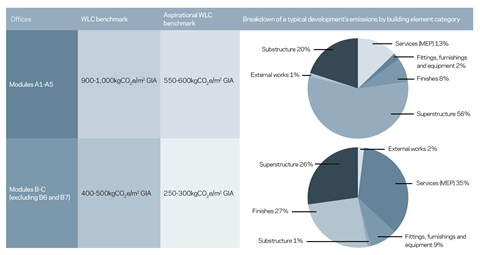
Figure 3: WLC benchmarks (excluding B6, B7 and D – operational energy use, operational water use, and reuse/recovery/recycling)
In the same way that cost budgets are set and controlled, the carbon budget sets out the target for whole life carbon, resulting in a carbon tracker that can be used to make key decisions, shape the project and test progress against targets at key design milestones.
BIM will play a vital part in the measurement of carbon and the setting of targets, with scope to include carbon emissions factors within modelled elements, enabling their quantification quickly and accurately.
Regulation is clearly a necessity to drive forward carbon reduction, but it should not be seen as a burden, given the potential benefits of an approach that is based on total cost of ownership.
04 / What are planners looking for?
Several London local authorities are progressing whole life carbon assessment as part of planning policy. The borough of Camden, for example, has a policy section on resource efficiency that includes a whole life carbon requirement. In May 2018, the mayor of London published the London Environment Strategy, which includes proposal 6.1.4.c: “to encourage the reduction of whole lifecycle building emissions (embodied carbon)”. This specifically references the RICS professional statement, Whole Life Carbon Assessment for the Built Environment.
The Greater London Authority’s 2019 draft London Plan includes, under policy SI2 (minimising greenhouse gas emissions), the requirement for whole life carbon assessments both on submission and post completion. This recognises that operational emissions alone are not a true representation of a building’s overall carbon emissions. In April 2020 the detailed guidance for policy SI2 on whole life carbon was published (co-authored by Simon Sturgis and Cundall). This sets out the requirements for whole life carbon reporting, including all stages in a building’s lifecycle – from A1 to D (as detailed in figure 1).The full range, from materials sourcing to reuse of a building at the end of its life, is effectively the circular economy in practice. The policy is currently only for referable schemes, but this will undoubtably expand into local plans and to include all significant built projects.
Figure 4 below illustrates the potential whole life carbon (WLC) performance improvements for new offices by adopting GLA policy SI2, using known construction methods and the Design for Performance (DfP) approach developed (by the Building Better partnership of UK commercial property owners) to improve energy performance in new offices. For the middle trajectory, construction costs would be cost-neutral or better, with in-use costs reduced. The red curve represents where we need to realistically get to (before offsetting).

Figure 4: WLC performance for a standard London office completed in 2020 – total tonnes of CO2e at five-yearly intervals
Assuming slow progression of National Grid decarbonisation
05 / What will the sustainable future office look like?
The property industry has long had a fascination with floor-to-ceiling glass, long, clear-span structures and raised floors, second-guessing its target audience while trying to be different. But future form and appearance must be shaped by much bigger factors than fashion.
The ultimate aim for developers and landlords is of course to attract occupiers to sign up to a long lease, say 15 years. But what happens afterwards? Once the occupier has moved on, the building is typically refitted internally (as a minimum) and often reclad to meet current market expectations, adding more floor area where possible, so that its value can be increased before selling it on.
There is a growing acceptance that office buildings previously considered sub-standard can produce spaces with character and charm that are attractive to a range of occupiers. An example is architect Orms’ reworking of the 1970s building at 160 Old Street, Islington, providing a flexible E-shape floorplan, exposing the concrete structure and creating a new entrance pavilion.
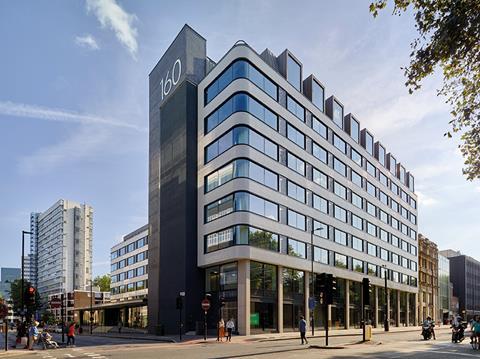
The days of considering refurbishments as difficult or compromised are surely numbered. To meet the UK’s net zero carbon targets, an increasing number of urban projects are likely to repurpose buildings that already exist rather than replace them with new ones. The technology now exists for achieving ultra-high energy performance, but the financial cost of sustainability has often been considered too high. That mindset has to change, and for it to do so, a whole life carbon as well as a whole life financial valuation will have to combine to frame a new form of business case.
Data is the new oil, we are told, and it is key to sustainable development, using standardised metrics and monitoring the operation of new proposals with technologies such as digital twins, which can facilitate the development of a database to optimise solutions for the short, medium and long term. Companies such as Centric Lab can help give insights into the profile of target audiences, identify their needs, and meaningfully inform how occupiers use speculative buildings.
BIM is an amazing tool for comprehensive modelling, analysis, understanding of performance, co-ordination and presentation of proposals, and must be a central plank in property development. From such models, architects as lead designers can inform design decisions and analyse data to explore embodied carbon and the potential impact on operational carbon. One of the major benefits of modelling at RIBA stage 1 is that both cost plans and carbon cost plans can be generated to help drive the best design solutions.
While real estate grapples with defining the next generation of offices, there remain certain core considerations that will continue to inform office design. They are: plan simplicity, site orientation, choice of structural grid and material, floor-to-floor heights, windows rather than unitised curtain walling and ventilation systems. Accepting the value of simplicity in key elements together with a longer-term view will contribute towards a reduction in embodied carbon and whole life carbon. But how do we go further, and can this define the next generation of office buildings?
Innovations that could be applied to future offices and make significant inroads in the challenge to reduce embodied carbon include:
- 3D printing Printing components such as cladding panels, concrete and stair moulds or even whole elements of the building would significantly reduce material wastage and transport emissions as printers could be hired locally and used adjacent to or on site. Dutch firm Aectual, for example, uses bioplastics with large 3D printers to build complex and sophisticated designs, from floors to facades, stairs and even entire buildings
- Designing for recycling The includes the use of materials created from upcycled waste such as Stonecycling’s waste based bricks, as well as the reuse of steelwork, which has been investigated by the Steel Construction Institute, with a protocol issued last year that identifies the benefits and challenges of how this could be applied.
- Growing materials BioMason is a start-up that has discovered a way of growing concrete bricks in ambient temperatures, which eliminates the need for firing them. Inspired by the formation of coral – a natural yet hard substance – the firm has created a method of “growing” cement bricks.
- Breathing buildings Researchers at Barcelona’s IAAC architecture school have developed a prototype material – hydroceramics – that passively cools buildings and reduces the internal temperature by as much as 5°C compared with the outside. It is a ceramic panel imbued with hydrogel, an insoluble polymer that can absorb up to 500 times its weight in water. On warm days, the water held in the polymer begins to evaporate, which has a cooling effect on the building – the IAAC describes it as the building “breathing” through evaporation and perspiration. The researchers suggest that buildings clad with this material would be 5°C to 6°C cooler than the outside temperature and could reduce air-conditioning use by about 28%.
- From buying to leasing Companies such as Phillips are offering a service to design, manufacture, install and maintain or replace light fittings throughout their operational life, and commit to recycle them once they are no longer required.
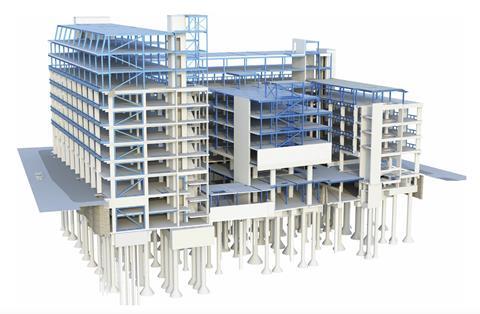
Figure 5: Retained (in white) versus new (in blue) structural components on 160 Old Street redevelopment
With 76% of structural components retained, this saved 2,856 tonnes of CO2 equivalent – equivalent in carbon emissions to 3,112 return flights from London to New York
A developer’s view: Great Portland Estates
In September 2019, Great Portland Estates signed the ground-breaking Better Buildings Partnership Climate Change Commitment, which requires us, by the end of this year, to set out our roadmap of how we will achieve a net zero carbon portfolio. This includes embodied carbon from development, refurbishment and fit-out works, which made up a third of our carbon footprint during the year ended 31 March 2020.
As we started work on our roadmap, the lack of consistency in information on embodied carbon across the industry became immediately apparent. While some top-tier contractors and design teams are familiar with tools such as the RICS Whole Life Carbon Assessment for the Built Environment and One Click, this is not the case across the board. Also, good-quality information for smaller refurbishment and category B fit-out works is virtually impossible to come by.
But data is not the only challenge. With every alternative material there are other issues to consider: fire safety, insurance requirements, structural loadings and industry standard specifications. Despite the scale of the challenge, the opportunity for innovation and, most importantly, the enthusiasm and knowledge of our professional teams and wider supply chain in supporting us to find solutions are clear.
Net zero carbon reviews are progressing for all our upcoming developments and refurbishments, along with forensic reviews of the actual embodied carbon in our developments currently on site.
Last month we launched The Time is Now, our statement of intent setting out our sustainability aims for the next decade. We have committed to decarbonising our business by 2030, reducing our embodied carbon emissions by 40% and energy intensity and carbon intensity across our occupied portfolio by 40% and 69% respectively by 2030. These targets have been included within our new ESG (sustainability and ethics) linked revolving credit facility. Each year progress against our targets will be tracked and reported to our lenders, impacting the interest rate of the credit facility and senior management bonus levels. Because what use are targets unless they are integrated, and if not now – when?
06 / How could the future office be funded and procured?
Globalisation is still alive but not in rude health, and covid-19 has highlighted the complexity and international nature of many supply chains. A cladding panel, for instance, might have been assembled in Europe but some of its components have been made in different parts of Asia. Consequently, the trade links supporting the procurement of a London office building are complex, interconnected and vulnerable to shocks.
From a risk management perspective, developers and construction firms may seek to bring production and supply chains closer to home, using more highly automated factories and processes, and materials from more sustainable, robust sources – which could also encourage a more local vernacular in architecture.
There have already been calls to improve the prevailing procurement model for commercial projects, because of problems caused by its fragmented nature and the opaque, sometimes skewed allocation of risks and rewards. Maybe now is the time to turn this procurement model upside-down, adopting a new approach to the funding and valuation of projects.
Due diligence in assessing real estate should be based on whole life costs (financial and environmental), with the resulting value one that reflects a long-term view. A sustainable building is usually seen as more expensive, yet if reducing carbon costs for construction and for operation leads to more efficient use of resources, then this should equate to a lower total cost of building ownership. If this approach is applied, then investment yields will reflect the better environmental credentials of a reused, adapted or improved building, or else a new building that has been designed for lower carbon impacts and with the whole life of the structure in mind.
It follows that it will become increasingly difficult to raise money for, insure or find tenants for a building that does not achieve a raised level of sustainability standards. The procurement model the industry uses must support this approach, not least through a closer relationship with subcontractors and suppliers, who could be given a greater incentive to help produce more flexible and durable buildings.
A manifesto for sustainable development
Integrate the financial, design and procurement processes to meet our zero carbon needs, attract the next generation of occupiers and create a long-term sustainable development model
Recognise that tenants, with duties of care to their employees, will become more explicit in demanding that buildings perform optimally in response to the climate crisis
Undertake full lifecycle assessments covering both the carbon and financial costs of constructing and using a building over its anticipated life
Prioritise the reuse of existing buildings and urban infrastructure, and the recycling of existing materials on site.
Design durable and flexible office products, with the minimum of mechanical systems
Prioritise low-carbon, recycled materials that are locally sourced, and aim for zero waste
Demonstrate at the design and procurement stages how, in the future, the building can be repurposed as a whole or as components. Today’s new-build is tomorrow’s retrofit
Develop a more integrated design–procurement–supply–construction chain where suppliers have a long-term stake in the performance of their products
Ensure that due diligence in assessing real estate value should include a whole life cost assessment, both carbon and financial, with value reflecting a longer-term view
Continue to improve the consistency of methodology and accuracy of data used in making carbon assessments.
07 / Conclusions
Crises often present an opportunity for a reset, or at least to accelerate trends that were already in play but perhaps were previously not given enough credence. Given that the World Bank has stated that in any given year climate change kills more people that covid has so far, now is surely the time for net zero carbon targets to be taken seriously.
Attitudes are changing, and data is catching up: the challenges of achieving consistency, accuracy and credibility in carbon models are being addressed, such that behaviours and technology will work together to evaluate the full carbon impacts of a project over its life (including its end-of-life stage). This could be supported by a recalibration of supply chains and a shake-up of procurement models, and, finally, proper digitalisation of design and building management.
This is an opportunity to challenge perceived wisdom and explore a carbon-led future for buildings. It would be some achievement if investors could boast about a solid financial return at the same time as significantly reduced embodied and operational carbon. Net zero carbon must be one race to the bottom that is worth winning.
Acknowledgments
The authors would like to acknowledge the contributions of Steve Watts and Thomas Atkinson of Alinea, Simon Sturgis of Targeting Zero, Oliver Richards and John McRae of Orms, and Helen Hare of Great Portland Estates plc



























No comments yet